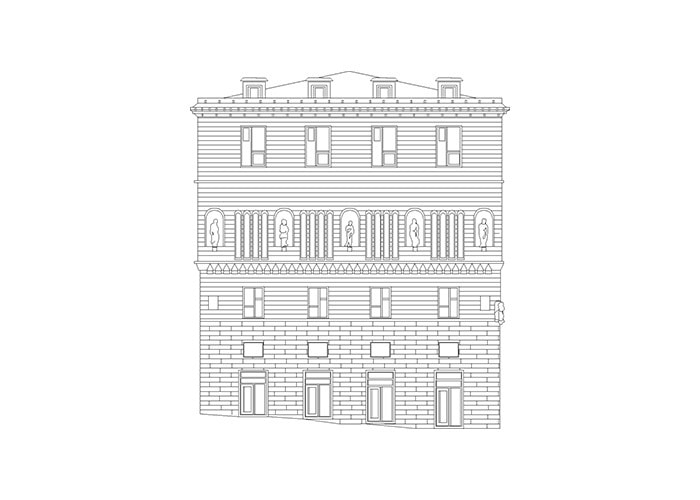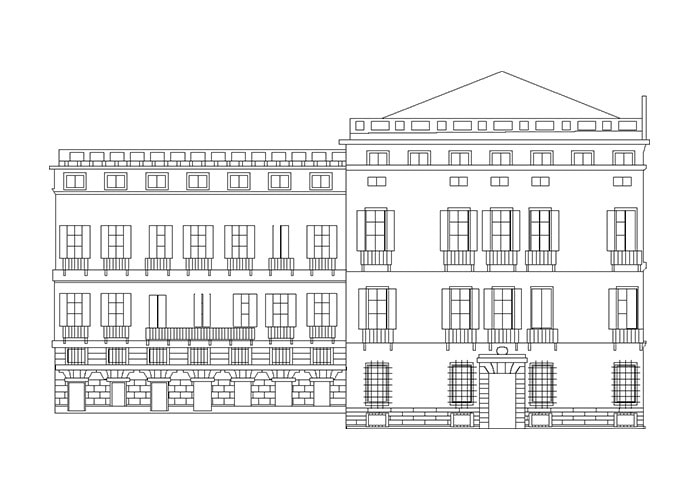
5. Palace of Giacomo Spinola
25 March 2022
7. Palace of Paolo and Niccolò Interiano
25 March 2022The palazzo, which overlooks piazza Fontane Marose with an unusually extended façade featuring no fewer than fourteen rows of windows and with twin doorways, owes its origin to the residence erected in 1560-1562 for Francesco de Ugarte, Spanish Ambassador to the Republic of Genoa.
The date of construction of this first building, which was built by combining two houses purchased by Guglielmo Spinola and corresponding to the western portion of the current building, places it in the same period as the start-up of the works on Strada Nuova, for which piazza Fontane Marose represented the old access.
In 1588, when the “Rollo” was drawn up for palazzi to be used to accommodate guests on state visits, ownership of the palazzo had already transferred to Luca Negrone. Alongside the same building, to the east, stood the palazzo of Gio. Batta Spinola q. Bernardo. The construction details of this building are not known, but at that time it was a palazzo considered worthy of inclusion on the same list. This latter building, ownership of which later passed to Gio.Tomaso Airolo, was rebuilt by the owner under the direction of the architect Bartolomeo Bianco by 1634, the date on which authorisation was obtained to build balconies protruding over public land; it was the son of Gio.Tomaso, Agostino – one of the richest men in the city, according to accounts of the time – who purchased the adjacent palazzo Negrone, amalgamated it with the paternal residence and started its interior decoration, towards the middle of the XVII century. This work included frescoes in one room by Gio.Maria Bottalla (1644) and Gioacchino Assereto, and, on the vault of the gallery located on the façade, by Giovanni Battista Carlone. Agostino Airolo died of the plague in 1657 laden with debts, and it must be due to these circumstances that the palazzo, which was by now quite large, changed hands once again. In 1664 it belonged to Giovanni Battista Negrone, a member of another branch of the family who had owned the west portion of the building. It fell to the grandson of Giovanni Battista, Gio. Antonio, in about 1700 to engage Domenico Parodi to fresco the vault of the room with The glory of the Negrone family, whilst it was another descendant who had the facade renovated by Antonio Barabino in the second half of the XVIII century. The last alterations carried out on the elevation date back to 1870, when the ground floor was raised, following the altimetric work in piazza Fontane Marose, and the doorway corresponding to no. 3 was constructed, replicating the seventeenth century layouts of no. 4.
Updated bibliography post 1998
F. R. Pesenti, Gli affreschi di palazzo Ayrolo Negrone. Le premesse e il seguito, in “Trasparenze”, 5/99 pp. 37-51.
A. Brena, P. G. Embriaco, E. Vassallo, Palazzo Negrone, in “Arkos”, supplemento al n. 7/2004 “Il restauro dei palazzi dei Rolli”, pp. 44-47.
E. Poleggi, Palazzo Negrone. Fontane Marose piazza di Strada Nuova, Genova 2008.
T. Zennaro, Gioacchino Assereto (1600-1650) e i pittori della sua scuola, Soncino, 2011.
The texts have been updated thanks to the INSIDE STORIES project financed with funds - Law no. 77 of 20 February 2006 "Special measures for the protection and enjoyment of Italian sites of cultural, landscape and environmental interest, included in the "World Heritage List", under the protection of UNESCO.



